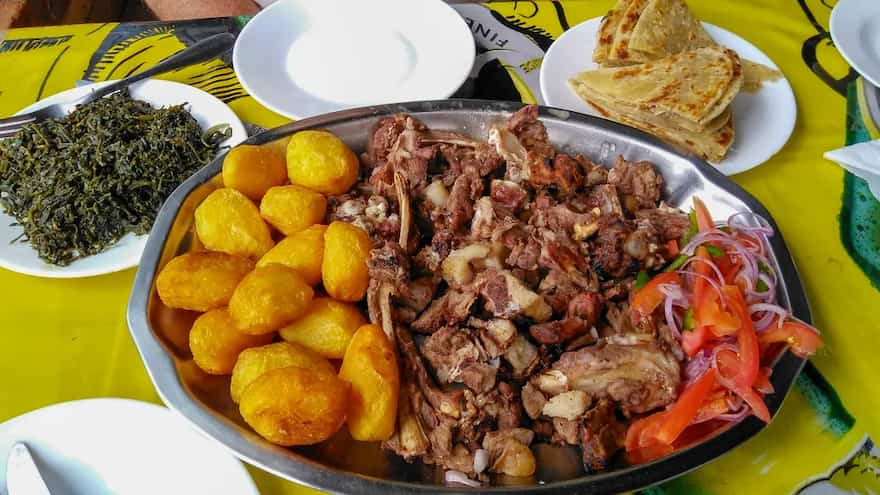Indian traders have been living along the east coast of Africa for centuries. When Vasco da Gama was on his voyage to discover a sea route to India, he encountered Indian traders in Malindi, a coastal town in present day Kenya. Indians, mainly from the Gujarat region, were accountants and bankers for Arab traders as well as the Portuguese in the region. During the British Raj, many Indians moved to Africa to set up shop. The creation of the East Africa Protectorate in 1895 saw a significant increase in Indian migration to Kenya. Their presence in African, and Kenyan, lands added flavors and dishes to a rich local cuisine that has evolved into an interesting mix of cultures.
Kenyan cuisine is quite varied, with many communities maintaining their own traditional cuisines. The staple foods include maize (cornflour), other cereals, and various meats and vegetables. The country also has a thriving coastal cuisine, which is particularly renowned. In the mid-15th century, the Portuguese introduced maize, cassava, and sweet potatoes to Kenyans. During this time, they also introduced tea. Another staple food is Ugali, a thick, mashed plantain dish. While many Kenyans are vegetarians by default, meat is also a major part of Kenyan cuisine.
Nyama Choma is the national dish of Kenya. This dish, which translates to "grilled meat" in Swahili, is made from grilled meat and is usually accompanied by a side of mash and salad. Nyama choma is served everywhere in Kenya - restaurants, cafes, and roadside food carts. It can be eaten on any day, and is very popular across the country. Although goat is an often-used meat in nyamachoma, beef is the most popular mat of choice in the country.

Another Kenyan favorite is Ingoho, a special stew of chicken made in the Luhya community in the western part of the nation.
Sukuma Wiki is another popular food in Kenya. It is made from various greens. The preparation is are usually very spicy and may include elements borrowed from Indian food. You can also find a version of sukuma wiki that is just plain greens, sauteed with onions and oil, without spices. These dishes are often eaten with stew or meat.
Food in Kenya has been significantly influenced by the sizeable Indian community. Many Indians in Kenya trace their roots to Gujarat, and Punjab, and the influence of Gujarati as Punjabi cultures and cuisines is quite evident. Chapatis and samosas are fairly commonplace. Punjabi laborers played a crucial role in building the railways that went into the interior of the country. And where they went, they took their food with them, leading to chapatis being found commonly in the inner depths of Kenya.
The humble, unassuming chapati is now popular in Kenyan restaurants and on the streets, and is often eaten with chili lime salt. The Kenyan version is more like a paratha than a traditional Indian chapati, what we in India now call phulka. Kenyans cook their chapattis on griddles, not directly on the fire. They also add some type of fat, sometimes directly in the dough, but usually on the pan. It even has its own Kenyan name – chapos. And chapos are now a part of many Kenyan households, with families including it in their weekly rotation of meals at home. Shops across Kenyan cities sell frozen chapatis, and you’ll even hear people lament the lack of authentic taste in these frozen chapatis, or stating their preference for the flakiness of their favorite chapati.
Kenyans are also known to enjoy githeri, a stew made of maize and beans, on occasion.

Samosas have proven to be a popular fast food in Kenya, and are often served as a light meal or as appetizers with a side of chutney and lime. Chutneys are also preferred with samosas, especially the kind that includes yogurt, chopped onions, coriander, and chaat masala. Some Kenyans also prepare a sweet version of the samosa, not unlike the Bengali singaras, which are triangular in shape and filled with potato, peas, onion, diced almonds, or a combination of vegetables.
Indian dishes like bhajia, a spicy fried dumpling, is popular across Kenya's cities. The dish is made with a batter of gram flour and spices and is often accompanied by mango chutney. The festival of Diwali is a big occasion every year, when Kenyans of Indian descent invite friends over and prepare elaborate Indian food to mark the festival of lamps.
Indian food is also viewed as neutral territory. Kenya’s rivalries are usually along tribal lines, with distinct traditions and practices. For instance, one tribe will consume meat that another considers taboo. Indian foods like chapati may have served as a meeting ground devoid of partisanship, and also did not carry the stigma of colonization like European food might have at one point.


